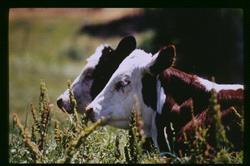Bob Judd, DVM, DABVP (Equine Medicine), DABVP (Canine and Feline Practice)
Two cows

Dr. Craig Loder writes in Drovers.com that a liver biopsy is helpful in diagnosing trace mineral deficiencies in dairy cattle. A liver biopsy extracts a tiny piece of liver tissue to evaluate for levels of trace minerals like zinc, selenium, copper, and manganese.
Dr. Louder indicates that most people tend to think in terms of bugs and drugs: which bug does the cow have, and which drug can I use to fix the problem?
By monitoring liver status, we can proactively solve health problems and treat the underlying issue or prevent disease. If a liver biopsy shows a trace mineral deficiency, these deficiencies can be corrected with a ration change or supplementation, which can increase reproductive efficiency.
In the past, liver biopsies were much more invasive, but now can be performed with a trucut biopsy needle with little risk to the animal. The needle is 14 gauge and is designed to be minimally invasive, taking only a ½ inch long sample from the right side of the cow’s liver.
The trace minerals the biopsy is testing for tend to wax and wane throughout the cow’s pregnancy cycle and are lowest at the time of calving. A significant percentage of minerals are transferred to the fetus, but the levels will increase again with the next pregnancy. The timing of the biopsy sample does not matter as long as it is correlated with the stage of reproduction. Checking cows as they freshen (a term used when cows begin producing milk after giving birth) and then again at dry-off (a resting period after lactation) is recommended.
Liver biopsies of calves can also be helpful to check their trace mineral status. However, it is a new procedure in the United States, as Dr. Louder reports about 75% of his audience of dairy producers had never had a liver biopsy performed.
Ask your bovine veterinarian for their opinion on testing liver biopsies of dairy cows to determine trace mineral status.